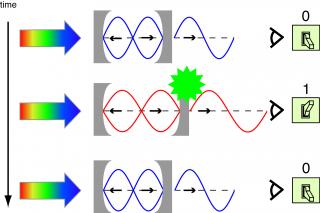Fibre optic cables transmit information so fast because they can make use of the unique properties of light and transmit many data channels at the same time. The digital 1s and 0s the light beams carry are imprinted onto the beams by semiconductors that in quick succession turn the light beam on and off. Unfortunately, that also puts a limit on the possible data rate, as materials switch slower than light. There are all-optical switches operating at the speed of light using special crystals, but what is needed are solutions that can be fabricated on a chip.
This is made possible now. Georgios Ctistis, Willem Vos, Jean-Michel Gérard and colleagues from the University of Twente and the FOM-Institute Amolf in the Netherlands, and the Institute for Nanoscience and Cryogenics in Grenoble in France have demonstrated that using a material to switch light is not a drawback anymore. They are able to switch a light beam within a semiconductor device at speeds of 0.3 picoseconds, where a picosecond is a millionth of a millionth second. That’s so fast that it approaches the limit set by the speed of light.

The principle of the ultimate optical switch. Top: a microcavity blocks the transmission of the red signal beam. Middle: in the presence of a control beam the cavity changes its properties and lets the beam pass. Bottom: as the control beam is off again, the switch also turns off. Figure provided by the authors.
In a conventional optical switch, a light beam (or an electrical voltage), is used to excite electrons in a semiconductor. These electrons then change the material’s optical properties in a way that switches the signal beam on or off. But this is a comparatively slow process. The idea here is to separate the optical effects from materials properties, which would only slow the device down. “The key advance is that both the switch-on and -off times of the semiconductor microcavity is completely determined by the properties of light itself,” says Vos.
[…]
Continue reading...
Following the letters of the law can sometimes lead to seemingly absurd situations. A university in Germany elects a new rector. Two months later the science ministry rejects her appointment, because she had previously cancer, and the possibility of a recurrence is too high for the government to accept. No, she doesn’t have cancer at present, but the mere possibility seemed enough to prevent her from taking her office.
Sounds incredible? Well, that’s exactly what happened to Renate Lieckfeldt (link in German), who got elected rector of the University of Leipzig, a college in the German state of Saxony end of last January.
The dilemma is that Lieckfeldt is a professor at a college in a different German State. And the law is that she has to become a civil servant of Saxony to assume her new position. In Germany, being a civil servant means that you have sponsored access to expensive medical healthcare, typically with much better privileges than those who are on general healthcare. All the way into retirement! And what at least I wasn’t aware is that apparently if you are in danger of costing the state a lot of money because of a medical condition it can mean you are denied becoming a civil servant. And that’s exactly what is the situation now.
Of course, this law isn’t only for university rectors, it holds for every civil servant there. Therefore, my feeling is that the state wants to avoid a costly precedent. So that’s what they follow the law without exception, even though I am sure there would be room for maneuver.
Still, looking beyond Lieckfeldt, what I find outraging here is that a government takes decisions on hypothetical medical conditions. Where would you stop this? Would you stop employing overweight people for the danger of them becoming diabetic? What if you have a gene that has you predisposed for certain diseases? Genetic profiling is widely criticized particularly in Germany. Yet, taking such a decision based on potential health implications such as that following prior cancer is little different in its consequences.
Governments have to lead by example. There are statistical possibilities lurking in all our genes. Stigmatizing the healthy for past and possible future diseases therefore seems just plainly wrong to me. The State of Saxony in my eyes would be wise to chose the first choice for the job – the already elected candidate.
Continue reading...

The visible spectrum of neon and its characteristic emission lines. By Jan Homann via Wikimedia Commons
In 1814 the German physicist Joseph von Fraunhofer observed narrow dark lines in the otherwise continuous spectrum of light emitted by the sun. Hundreds of them. As Gustav Kirchhoff and Robert Bunsen later showed, these lines correspond to the absorption of light by various chemical elements in the sun. Each element has its own unique set of lines that correspond to energetic transition between the electronic states of these atoms. This discovery has laid the foundation to the field of spectroscopy, where the interaction of matter and light is probed.
A study published in Nature Physics this week by Hartmut Abele and colleagues from the University of Vienna in Austria now reports how gravity can be used instead to probe quantum states. And they’re not using atoms either, but neutrons, which are the electrically neutral particles in the atom’s core.
These neutrons are produced in nuclear research reactors, for example at the Institute Laue-Langevin (ILL) in Grenoble, which I visited last year. In fact, the experiment by Abele and colleagues was done at ILL because there ultracold neutrons are available for research – “still the only source of ultracold neutrons for users in the world,” says Peter Geltenbort from the ILL, who took part in the experiments. […]
Continue reading...




April 29, 2011
11 Comments